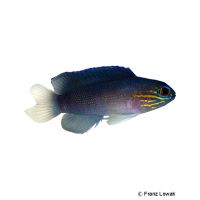Yellowlined Basslet (Gramma linki)
| Yellowlined Basslet Gramma linki | |
|---|---|
| Name | Yellowlined Basslet |
| Name Lat. | Gramma linki |
| Family | Basslets |
| Family lat. | Grammatidae |
| Order | Ovalentarias |
| Order lat. | Ovalentaria inc. sed. |
| Origin | Caribbean, Gulf of Mexico |
| Habitat | Reefs, caves |
| Diet | Planktivore, invertivore |
| pH | 8.1-8.4 |
| Hardness | 8-10 °KH |
| Behavior | Semi-aggressive |
| Keeping | Individual, pair |
| Reef Compatible | Yes |
| Care Level | Moderate |
| Life Span | 3-5 years |
| Protection | No |
| Metric Units | |
| Size | 7 cm |
| Temperature | 20-26 °C |
| Salinity | 33-36 ‰ |
| Aquarium | ~ 250 l |
| US Units | |
| Size | 3" |
| Temperature | 68-79 °F |
| Salinity | 1.020-1.025 sg |
| Aquarium | ~ 60 gal |
Distribution and habitat
The distribution area of the halter fairy bass is the western Atlantic, from Bermuda through Florida, the Gulf of Mexico and the Caribbean to northern South America. There they prefer to live in caves and crevices on coral reefs.
Maintenance
They need a well-structured aquarium with a reef structure that allows for territoriality (crevices, caves and shelters), with live stones that they can graze on and that act like a biological filter. Only lime-rich, heavy metal-free sands, gravels, stones or sea sand of various grain sizes may be used as substrate
Filters, skimmers and heaters are necessary to ensure water quality, as well as pumps to simulate tides, swells and bottom currents. Lighting must correspond to the species-appropriate day-night rhythm of the animals
| Salinity: 33-36 ‰ | pH value: 8.1-8.4 |
| Carbonate hardness: 8-10 °KH | Nitrate content: 2-8 mg/l |
| phosphate content: 0.01-0.1 mg/l | nitrite content: 0.0-0.05 mg/l |
For salinity, an average value should be aimed for, which may only vary slightly by +/- 0.5 ‰. Ammonia and ammonium must not be measurable. Special attention must be paid to constantly good water quality.
Diet
They feed mainly on small crustaceans and zooplankton. The feed change usually succeeds without problems. The food supply should consist of a commercial, vitamin-enriched frozen special food mix or a combination of live and frozen food, such as small mysis, krill, bosmids and artemia with chopped fish, shrimp, mussel and squid meat. High quality dry food (flakes, granules) is also occasionally accepted. It is recommended to feed small portions several times a day (3-5 times)
Regular and varied feeding promotes health and increases resistance.
Behaviour and compatibility
It is recommended to keep them in pairs. To avoid turf wars, they should be placed in the aquarium at the same time. They form a small territory around their living caves, which is defended. Keeping multiple pairs is only recommended in a larger, very highly structured aquarium. They can be socialized well with other peaceful fish.
Sex dimorphism
They are presumed to be sequential hermaphrodites, meaning that they possess both male and female sex expressions. External sexual characteristics are not known.
Reproduction and breeding
There are isolated breeding reports about successful breeding in the aquarium. The fry is guarded by both parents.
Important
It is recommended to keep these reef dwellers together with corals and not to keep them in a fish-only aquarium, where they also often suffer from food competition
If different species are kept together, care should be taken to ensure that the fish match each other in terms of water quality and temperature requirements, as well as their social behavior, and that the setup meets the needs of all species kept together. Newly introduced fish must be acclimated slowly to the water in the aquarium.
Further literature can be found in your pet store.
References
Text: petdata; Image: Franz Lowak
Source: BAENSCH & DEBELIUS (2006): Meerwasser Atlas Bd. 1, Mergus Verlag; ENGELMANN (2005): Zootierhaltung - Tiere in menschlicher Obhut: Fische, Verlag Harri Deutsch
- Gemäß § 21 Abs. 5 Tierschutzgesetz idgF
